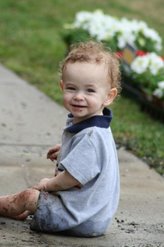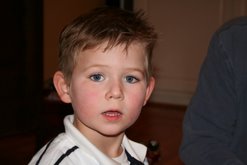Chrissy and I would like to thank all of our family and friends who have taken the time to call, write and pray on behalf of our son Holt. It was confirmed today that he is one of the few people in this world who will spend a lifetime fighting this dreadful condition known as Cystinosis. To learn more about this condition click on the link below (I have cut and pasted some of the FAQ's). Thank you so much for all of your support, it is greatly appreciated.
WHAT IS CYSTINOSIS?
Cystinosis is a metabolic disease characterized by an abnormal accumulation of the amino acid cystine in various organs of the body such as the kidney, eye, muscle, pancreas, and brain. Different organs are affected at different ages.
WHAT CAUSES CYSTINOSIS?
The cystine content of cystinotic cells averages 50-100 times the normal value. The cause is a defect in the transport of cystine out of a cell compartment called the lysososme, in which cystine accumulates. Because of cystine's low solubility, this amino acid forms crystals within the lysosomes of cells, and this is probably what destroys the cells.
WHAT ARE THE SYMPTOMS?
There are three clinical forms of cystinosis. Infantile (or nephropathic) cystinosis; late-onset cystinosis; and benign cystinosis. The latter form does not produce kidney damage. Infantile and late-onset cystinosis differ in the age of appearance of the first symptoms and in the rapidity of the clinical course. Infantile cystinosis is usually diagnosed between 6 and 18 months of age with symptoms of excessive thirst and urination, failure to thrive, rickets, and episodes of dehydration. These findings are caused by a disorder called renal tubular reabsorb nutrients and minerals. As a consequence, these important molecules are lost in the urine. Children with cystinosis also have crystals in their eyes (after one year of age) and an increased level of cystine in their white blood cells. Without specific treatment, children with cystinosis develop end-stage renal failure, i.e., lose their kidney function, at approximately 9 years of age.
If cystinosis patients receive a kidney transplant and reach adulthood, their new kidney will not be affected by the disease. However, without cysteamine treatment (see below), they can develop complications in other organs due to the continued accumulation of cystine throughout the body. These complications can include muscle wasting, difficulty swallowing, diabetes, hyperthyroidism, and blindness. Not all older patients develop these problems, however.
CAN CYSTINOSIS BE TREATED?
The symptomatic treatment of the Fanconi syndrome is essential. The urinary losses of water, salts, bicarbonate, and minerals must be replaced. Most children receive a solution of sodium and potassium citrate, as well as phosphate. Some also receive extra vitamin D.
The aim of specific treatment for cystinosis is to reduce cystine accumulation within the cells. This goal is achieved by cysteamine treatment, which has proven effective in delaying or preventing renal failure. Cysteamine also improves growth of cystinosis children. The Food and Drug Administration (FDA) has approved a capsule form of cysteamine called CYSTAGON . .
Kidney transplantation has proven very helpful in patients with cystinosis, and cysteamine therapy should be considered to try to prevent the late complications of the disease (see above).
For both young children with cystinosis and older patients with a kidney transplant, cysteamine eyedrops may be available to remove the corneal cystine crystals. However, these are not yet approved by the FDA.
HOW IS CYSTINOSIS INHERITED?
Every person's body is made up of millions of tiny structures called cells. Each cell comes with a full set of instructions which tell the cell what to do and how to make our bodies work. The instructions are called genes, and they are made from a chemical called DNA. Genes usually come in pairs, and they determine everything about our bodies. For example, certain genes determine the color of our eyes, while other genes determine our blood type.
Genes are often called the units of heredity because the information they contain is passed from one generation to the next. We all get one gene in each pair from our mothers and the other gene in the pair from our fathers. In this way our bodies work with a combination of instructions inherited from both our parents. Parents have no control over which genes get passed to their children.
Cystinosis is called a recessive genetic disease, because parents do not exhibit symptoms, but they each carry a recessive gene which may cause Cystinosis in their children. The genetic path of Cystinosis is therefore impossible to predict, and a cystinotic child is almost always a shock to parents. The recessive gene may lie dormant for many generation until suddenly two people with the defective gene have children.
Each time two such Cystinosis carrier have a child together, there is a1-in-4 chance (25% risk) of having a child with Cystinosis. and every healthy sibling of a child with Cystinosis has a 2-in-3 chance (66% risk) of being a carrier, like his parents.
Cystinosis is a rare, inherited, metabolic disease that is characterized by the abnormal accumulation of the amino acid cystine in each cell. The build-up of cystine in the cells slowly and eventually destroys all major organs of the body including the kidneys, liver, eyes, muscles, bone marrow, thyroid and brain. Although medication is available to control some of the symptoms of this insidious disease, Cystinosis remains incurable.

Wednesday, February 28, 2007
Subscribe to:
Post Comments (Atom)








5 comments:
Mike and I are committed to praying for your family, and especially Holt in this crisis. We are so sorry you are going through this. Thanks for keeping us updated.
I have passed this on to my prayer group as well.
Holt, you & all your family are in our thought & prayers. Wesley & I love you all very much! Please let us know if there is anything that we can do for you.
I have forwarded this on to my prayer group too.
Jason & Chrissy,
Thank you for sharing your update and allowing us to pray for Holt, the two of you and your family. The picture of the kids is gorgeous and I can't believe how much Mary Logan looks like Chrissy.
What a beautiful family.
Chrissy Eubanks
Jason & Chrissy,
I can't help but pray for Holt all day as I go about business. He's on my mind all the time. I'm praying that his eyes are fine, despite the crystals, that his kidneys remain strong, that his bones grow strong, and that his G-tube doesn't cause you guys or him any trouble. My cousin Rhonda's baby has one, and it's been just fine. Last night, my 3 year old daughter and I were saying prayers for him... and I said, "heal his eyes and kidneys" and Ava said, "and his bones." Anyway, we love you guys.
Post a Comment